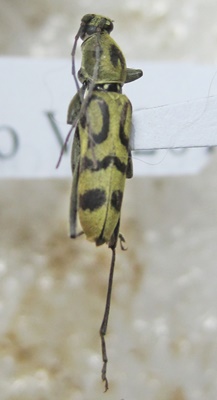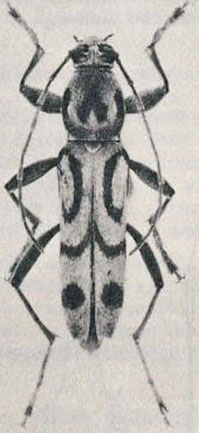| Author |
 Topic Topic  |
|
|
BillTyson
Member Rosenbergia
   
USA
1200 Posts |
 Posted - 28/10/2015 : 22:30:02 Posted - 28/10/2015 : 22:30:02



|

26.04 KB
Tam Dao, June, 10 mm |
Edited by - Gerard on 30/01/2016 13:40:37 |
|
|
Xavier
Scientific Collaborator
    
France
12215 Posts |
 Posted - 29/10/2015 : 11:34:00 Posted - 29/10/2015 : 11:34:00



|
Probably something close to Chlorophorus insidiosus Holzschuh, 1986 known from Nepal and Yunnan; but I wonder how it is possible to separate the close species  . .

Chlorophorus insidiosus Holzschuh, 1986 HT |
 |
|
|
BillTyson
Member Rosenbergia
   
USA
1200 Posts |
 Posted - 29/10/2015 : 15:21:11 Posted - 29/10/2015 : 15:21:11



|
Except for the lack of dark lateral pronotal marking, it looks like a match to me.
Many thanks |
 |
|
|
Xavier
Scientific Collaborator
    
France
12215 Posts |
 Posted - 30/10/2015 : 20:33:34 Posted - 30/10/2015 : 20:33:34



|
The problem is that C. Holzschuh has described many "new" species from this area, whereas I am unable to find tens of holotypes from Pic at MNHN-Paris.
How is it possible to describe new species without those specimens? It is a shame. |
Edited by - Xavier on 30/10/2015 23:51:20 |
 |
|
|
BillTyson
Member Rosenbergia
   
USA
1200 Posts |
 Posted - 30/10/2015 : 22:09:30 Posted - 30/10/2015 : 22:09:30



|
| One of the major problems doing systematics. Unless you are rich and can travel everywhere to search for types, doing a good job is sometimes not possible. |
 |
|
|
Xavier
Scientific Collaborator
    
France
12215 Posts |
 Posted - 30/10/2015 : 23:23:31 Posted - 30/10/2015 : 23:23:31



|
No, you do not understand. I know exactly where the types should be !
I said that most of types species of Chlorophorus described by Maurice PIC or CHEVROLAT and located at MNHN-Paris are LOST. Nobody knows where they are (destroyed, broken, ...).
Holzschuh has described many new species of Chlorophorus from south-east Asia - which is incredible - on the base of Pic's descriptions ! (most of the times, 3 lines in Latin) |
Edited by - Xavier on 30/10/2015 23:30:08 |
 |
|
|
BillTyson
Member Rosenbergia
   
USA
1200 Posts |
 Posted - 31/10/2015 : 16:05:18 Posted - 31/10/2015 : 16:05:18



|
| Understand. That really creates problems. |
 |
|
| |
 Topic Topic  |
|


